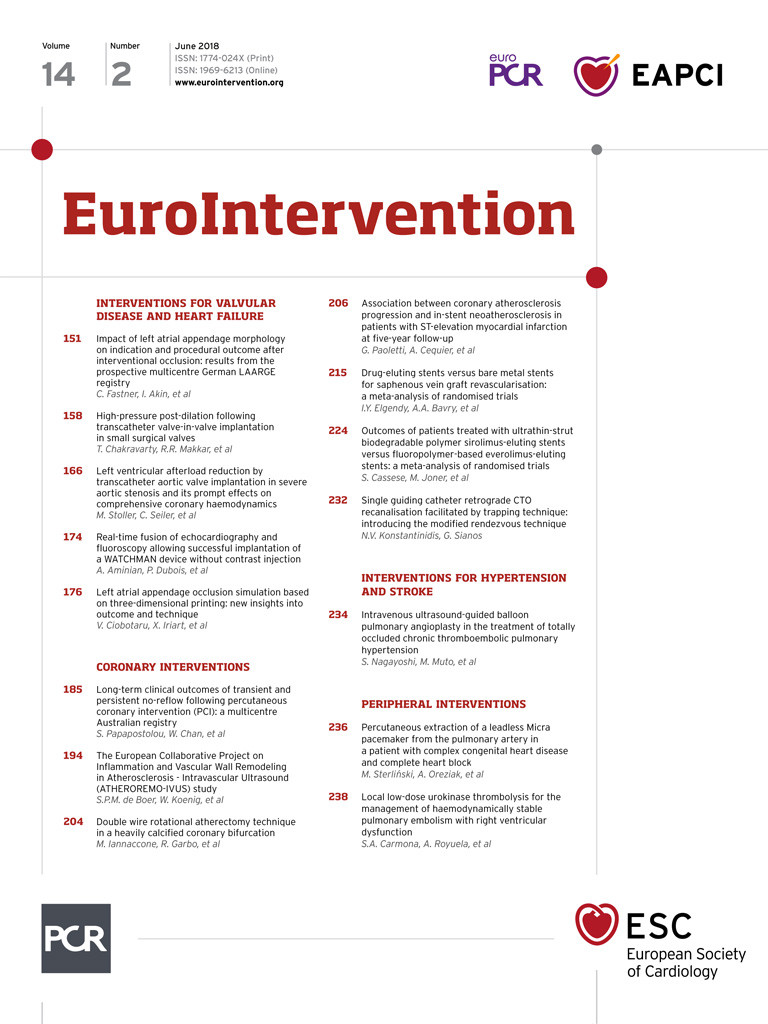
Saphenous vein grafts (SVG) are known to be more susceptible to accelerated atherosclerosis than native coronary arteries1. Accelerated atherosclerosis in SVG develops from resident foam cells, which then undergo apoptosis to form necrotic cores1. The attrition rate of SVG is around 2% per year for the first seven years, rising to 5% per year thereafter. Less than half of all SVG remain patent by 10 years. SVG intervention is usually undertaken in a group of patients carrying a higher risk profile, accounting for around 10% of all percutaneous coronary intervention (PCI) cases1.
RRISC (Reduction of Restenosis In Saphenous Vein Grafts With Cypher Sirolimus-Eluting Stent)2 was the first randomised controlled trial (RCT) to evaluate the performance of the first-generation drug-eluting stent (DES) against bare metal stents (BMS) in a small cohort of patients. Those randomised to DES had a lower restenosis rate at six months but, after a median follow-up of 30 months, there was a signal towards more mortality in the DES arm3. This landmark study raised questions around the safety of DES in this setting and led to the conduct of four other RCTs.
With this in mind, in this issue of EuroIntervention, Elgendy and colleagues4 have undertaken an elegant, up-to-date meta-analysis of the five RCTs that studied outcomes comparing BMS versus DES in more than 1,500 patients.
After a weighted mean follow-up of two years, the authors report that there were no statistically significant differences in the risk of all-cause and cardiovascular mortality, myocardial infarction (MI), stent thrombosis (ST) and target vessel revascularisation (TVR), although there was a trend towards more deaths in the DES arm and a trend towards more MI, ST and TVR in the BMS arm. They concluded that DES was safe for SVG PCI, but not associated with superior outcomes to BMS. Of note, as the authors acknowledge, four of the five RCTs used first-generation DES and even the DIVA trial utilised first-generation DES in around 10% of cases in patients randomised to the DES arm.
Over the past decade, there have been numerous advances in stent platforms and antiplatelet agents, and first-generation DES have now been superseded by second- and third-generation DES, with thinner struts, more biocompatible polymers (both durable and bioresorbable) that are associated with better safety outcomes in the longer term. For example, a recent meta-analysis of 51 clinical trials including over 52,000 patients demonstrated that newer-generation DES were associated with lower rates of mortality, ST, and MI compared to both BMS and first-generation DES in native coronary arteries5. The most recent DIVA trial (Brilakis ES. A Multicenter, Randomized-Controlled, Blinded Trial of Drug-Eluting vs. Bare Metal Stents in De Novo Saphenous Vein Graft Lesions. In: ESC Congress. Barcelona, Spain, 2017) is the only RCT to use the second-generation DES in a double-blinded RCT, although only in 89% of cases. The primary endpoint was a composite of cardiac death, target vessel myocardial infarction or TVR at one year. Notable inclusion criteria were those with de novo SVG lesions with the intended use of embolic protection devices, whilst those with ST-segment elevation myocardial infarction, the target SVG being the last remaining vessel or left main stem equivalent were excluded. A total of 597 patients were included in the final analysis. There was no difference in the composite primary endpoint at one year (17% in the DES arm versus 19% in the BMS arm, p=0.67) or after a longer period of follow-up (median of 2.7 years, 37% versus 31%, p=0.15). Given the limited RCT data around outcomes in SVG in patients receiving second-generation DES, where does this leave us? Currently, there are no other RCTs registered on www.clinicaltrials.gov (last accessed on 27 April 2018). The majority of outcome data presented in the current meta-analysis were derived from procedures undertaken using first-generation DES, with no further contemporary data derived from RCTs forthcoming.
Whilst retrospective observational studies have the inherent limitations of being non-randomised and suffer from selection and reporting bias, they can provide valuable insights into real-world outcomes, and have the advantage that they provide outcome data in contemporary national cohorts of patients undergoing PCI using contemporary stent platforms, in an unselected all-comer setting, in cohort sizes that are several magnitudes larger than an RCT. They are therefore statistically powered to detect differences in clinical outcomes that much smaller RCTs may not be adequately powered to detect.
Recent data from the British Cardiovascular Intervention Society (BCIS) and National Institute of Cardiovascular Outcome Research (NICOR) registry including more than 15,000 all-comers undergoing SVG PCI showed that the use of a second-generation DES in over 7,000 patients was associated with a decreased mortality risk when compared to over 5,600 patients treated with BMS after a follow-up period of up to one year (odds ratio 0.60 [0.51-0.71], p<0.001), but this difference was not observed in over 2,200 patients treated with first-generation DES6. Findings from an RCT, despite its strengths, may not be representative of real-life cohorts of patients referred for SVG PCI. For instance, the findings from the DIVA trial are only applicable to a selected group of patients with a de novo SVG lesion. Only one in six patients screened for the trial was eventually included and 99% of the patients were male.
Finally, although BMS have conventionally been used in older, multi-morbid patients at high risk of bleeding complications where shorter DAPT duration would be preferable, the recent LEADERS FREE trial (A Prospective Randomized Comparison of the BioFreedom Biolimus A9 Drug Coated Stent Versus the Gazelle Bare Metal Stent in Patients With High Risk of Bleeding) demonstrated superior outcomes associated with the BioFreedom™ DES (Biosensors Europe SA, Morges, Switzerland) compared to a BMS with respect to the primary safety and efficacy endpoints, when used with a one-month course of DAPT in patients at high risk of bleeding complications7. Currently, there are several similar RCTs using other contemporary platforms underway and therefore the role and advantages of using a BMS in contemporary practice are uncertain. It is therefore likely that the use of BMS in native coronary artery disease will decline further. The current meta-analysis suggests that there are no disadvantages associated with the use of DES in SVG PCI, and large contemporary observational data sets suggest that there may even be an association with reduced odds of mortality/major adverse cardiovascular events when second-generation DES are used. With newer DES platforms, where more abbreviated antiplatelet regimes can be used, there are no clear downsides in using DES in SVG PCI. The use of DES, in particular second-generation DES, should remain the current strategy of choice for SVG PCI. The current meta-analysis supports its safety and efficacy in the intermediate term.
Conflict of interest statement
The authors have no conflicts of interest to declare.

